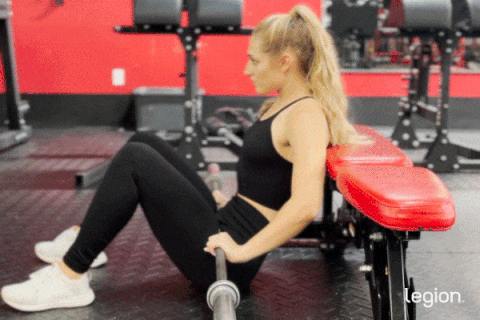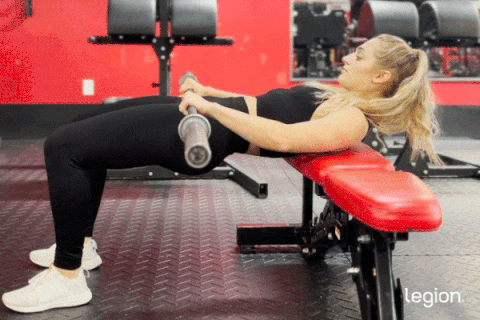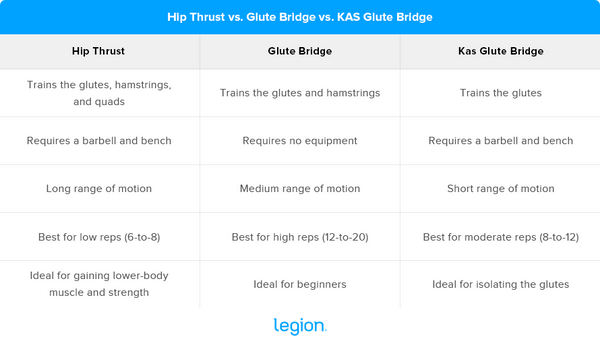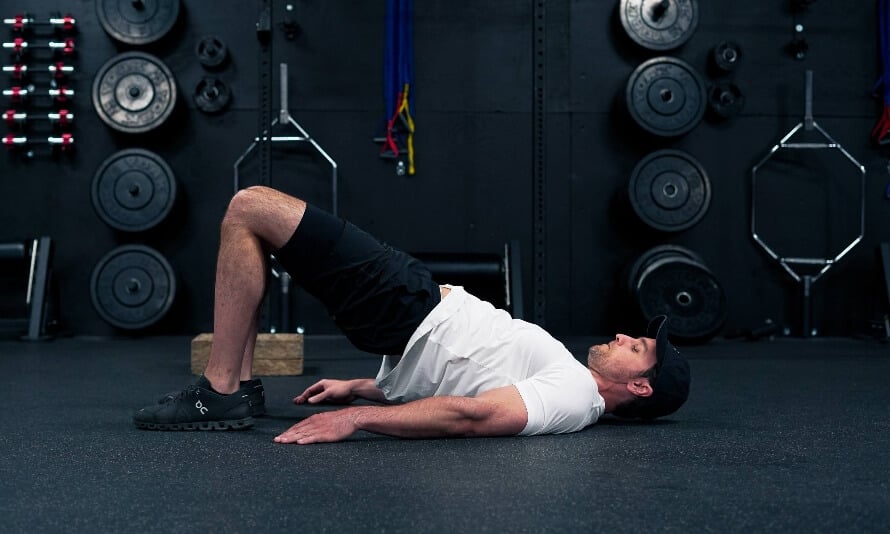Evidence Based
The glute bridge, hip thrust, and Kas glute bridge are three popular glute exercises.
Because each trains similar muscles and looks alike, many don’t understand how they differ and can’t distinguish one from the next.
In this article, you’ll learn what the glute bridge, hip thrust, and Kas glute bridge are, how they’re different, how to perform each, and which is best for you.
What Is A Glute Bridge?
The glute bridge is a bodyweight exercise that primarily trains the glutes and hamstrings.
It involves lying on your back with your knees bent and feet flat on the floor and thrusting your hips toward the ceiling.
It’s popular among new weightlifters because it’s easy to learn and allows you to start with just your body weight and build strength over time.
It’s also highly adaptable. For example, most glute bridge variations use only your body weight (e.g., the marching, elevated, and single-leg glute bridge), though several others involve added weight (e.g., the barbell, dumbbell, and Smith machine glute bridge).
Thus, you can always find an effective glute bridge variation to include in your workouts, no matter how you like to train or what equipment you have available.
How to Do A Glute Bridge

Model: Rachael Becker
- Lie on your back on the floor with your arms by your sides and your palms facing the floor.
- Place your feet 15-to-18 inches apart, about 6-to-12 inches from your butt, and point your toes slightly outward.
- Lift your butt off the floor by pressing your shoulders and heels into the floor, pushing your knees out in the same direction as your toes, and squeezing your glute muscles.
- Continue thrusting your hips upward until your butt, hips, and knees form a straight line and your shins are vertical.
- Reverse the movement and return to the starting position.
What Is A Hip Thrust?
The hip thrust is a barbell exercise that trains the glutes, quads, and hamstrings.
It involved thrusting a barbell toward the ceiling by lifting your hips while lying with your shoulders on a bench and your body perpendicular to it.
For many, the barbell hip thrust exercise is ideal for glute gains because it allows you to lift heavy weights safely and progress regularly, which is vital for gaining muscle and strength.
Because of how you position the barbell, the hip thrust also forces your glutes to work hard throughout the entire range of motion. This isn’t the case for most other glute exercises, where glute muscle activity typically drops at some point during the exercise.
How to Do A Hip Thrust

Model: Rachael Becker
- Sit on the ground with your back resting against a bench. The bench should be perpendicular to your body, and your shoulders should be resting on the middle of the bench.
- Roll a barbell over your thighs so that it sits in your hip crease (use a bar pad to protect your hip bones and make the exercise more comfortable).
- Plant your feet on the floor about shoulder-width apart and 12-to-18 inches from your butt so your knees are bent to about 90 degrees.
- Push the bar upward with your hips by pressing through your heels until your upper body and thighs are parallel to the ground and your shins are vertical.
- Reverse the movement and return to the starting position.
What Is A Kas Glute Bridge?
Unlike the regular glute bridge and hip thrust, which also involve muscles like the quads and hamstrings, the Kas glute bridge “isolates” the glutes.
Despite its name, the Kas glute bridge is more similar to the hip thrust than the glute bridge. In fact, the Kas glute bridge is essentially a hip thrust with a shorter range of motion.
The main benefit of the Kas glute bridge is that it forces you to perform slow and controlled reps, preventing you from using momentum to cheat the weight up. Using this technique ensures your glutes do most of the work, which benefits glute gains.
How to Do A Kas Glute Bridge

Model: Rachael Becker
- Sit on the ground with your back resting against a bench. The bench should be perpendicular to your body, and your shoulders should be resting on the middle of the bench.
- Roll a barbell over your thighs so that it sits in your hip crease (use a bar pad to protect your hip bones and make the exercise more comfortable).
- Plant your feet on the floor about shoulder-width apart and 12-to-18 inches from your butt so your knees are bent to about 90 degrees.
- Push the bar upward with your hips by pressing through your heels until your upper body and thighs are parallel to the ground and your shins are vertical.
- Lower your butt 3-to-6 inches, ensuring your shins remain vertical.
- Thrust your hips toward the ceiling and return to the starting position.
Hip Thrust vs. Glute Bridge vs. KAS Glute Bridge: Differences
All three exercises train hip extension (moving your thighs away from your upper body), which is the glutes’ primary function. As such, all three are effective glute exercises that are more similar than different.
That said, there are a few slight differences between each.
First, you set up each exercise differently. Typically, you do glute bridges on the floor using only your body weight, whereas you use a barbell and a bench to perform the Kas glute bridge and hip thrust.
Second, the hip thrust has a longer range of motion than the regular and Kas glute bridge. This is significant because exercises with a longer range of motion are generally better for muscle and strength gain.
Lastly, the glute bridge is the only exercise to which you usually don’t add weight. While this makes the glute bridge easy to learn and accessible to those new to weightlifting, it limits its muscle- and strength-building potential—something that isn’t an issue for the hip thrust and Kas glute bridge.
Hip Thrust vs. Glute Bridge vs. KAS Glute Bridge: Which Is Best for You?
While all three exercises are a means to the same end, your circumstances may make one more suitable than the others. Here’s a breakdown to help you decide which is best for you.

You May Also Like
Our Most Popular Evidence-Based Articles
You don’t need supplements to build muscle, lose fat, and get healthy. But the right ones can help.
Take our 60-second quiz now to learn which supplements can help you achieve your fitness goals faster.
Sending…
Your free stuff is on the way!
Follow the Diet Plan that Helped Nikita Lose 15 Pounds in 3 Months
“I never thought getting in shape would be this simple! Everything just WORKS when you follow this plan.” And if he can do it, why not you?

Wait!
Want a Free Custom Meal Planning Tool?
Quickly calculate your calories, macros, and micros for losing fat, building muscle, and staying healthy.
Our “No Return Necessary”
Money-Back Guarantee
If you don’t like something of ours, guess what happens next?
No, we don’t request you deliver it to a PO box in the Gobi Desert by carrier pigeon. Nor do we ask you to fill a cursed inkwell with orc’s blood and demon saliva and then use it to complete reams of return forms written in ancient Cyrillic script.
We just . . . wait for it . . . give you your money back. Holy moo cows. And that means you can say “yes” now and decide later.
Free Worldwide Shipping & Returns
Many companies use shipping and handling fees to increase their profit margins, but here at Legion, we hate profits, so our shipping is free!
Okay, so we do dig on profits, but we also go in for happy customers, and free shipping works like gangbusters. So, if you live in the United States, your order ships free regardless of order size, if you live in the UK or Canada, your order ships free when it’s over $99, and if you live elsewhere, your order ships free when it’s over $199.
Also, if you don’t absolutely love our stuff for whatever reason, we don’t request you deliver it to a PO box in the Gobi Desert by carrier pigeon.
We just . . . wait for it . . . give you your money back. No returns. No forms. No nonsense. Holy moo cows.
That means you can say “yes” now and decide later. You really have nothing to lose.
Free Worldwide Shipping & Returns
Many companies use shipping and handling fees to increase their profit margins, but here at Legion, we hate profits, so our shipping is free!
Okay, so we do dig on profits, but we also go in for happy customers, and free shipping works like gangbusters. So, if you live in the UK or Canada, your order ships free when it’s over $99.
Why the restriction on international orders? Unfortunately, shipping abroad is very expensive, and if we didn’t require a minimum order size, we’d lose a lot of money. But! We’re also hustling to improve our international logistics and will be passing our savings along to our international customers.
Also, if you don’t absolutely love our stuff for whatever reason, we don’t request you deliver it to a PO box in the Gobi Desert by carrier pigeon.
We just . . . wait for it . . . give you your money back. No returns. No forms. No nonsense. Holy moo cows.
That means you can say “yes” now and decide later. You really have nothing to lose.
Free Worldwide Shipping & Returns
Many companies use shipping and handling fees to increase their profit margins, but here at Legion, we hate profits, so our shipping is free!
Okay, so we do dig on profits, but we also go in for happy customers, and free shipping works like gangbusters. So, if you’re outside the USA, your order ships free when it’s over $199.
Why the restriction on international orders? Unfortunately, shipping abroad is very expensive, and if we didn’t require a minimum order size, we’d lose a lot of money. But! We’re also hustling to improve our international logistics and will be passing our savings along to our international customers.
Also, if you don’t absolutely love our stuff for whatever reason, we don’t request you deliver it to a PO box in the Gobi Desert by carrier pigeon.
We just . . . wait for it . . . give you your money back. No returns. No forms. No nonsense. Holy moo cows.
That means you can say “yes” now and decide later. You really have nothing to lose.
Clinically Effective Ingredients & Doses
Many ingredients in supplements don’t have any scientifically validated benefits, and many ingredients that do are often underdosed to the point of irrelevance.
That’s why we only use the choice ingredients and precise doses shown to be effective in peer-reviewed scientific studies.
Clinically Effective Doses
You need more than great ingredients to make great products—you also need proper doses. That’s why we use the precise doses of ingredients shown to be effective in peer-reviewed scientific studies.
100% Natural Ingredients
“Natural” doesn’t always mean “better,” but in many cases, natural ingredients are superior to artificial ones for various reasons, including purity, safety, and efficacy.
That’s why all of our ingredients in all of our products come from plant and animal sources, including sweeteners, colors, and flavors.
Made in USA
If you want to ensure the supplements you’re swallowing every day are safe and effective, you want products produced in the USA.
That’s why all of our supplements are made in America in NSF-certified and FDA-inspected facilities that operate in accordance with the Current Good Manufacturing Practice (cGMP) regulations.
Lab Tested
Did you know that supplements can contain dangerously high levels of toxins like lead, arsenic, and cadmium?
That’s why we test every ingredient of every supplement we produce for heavy metals, microbes, allergens, and other contaminants and ensure they meet the strict purity standards set by the FDA.
Naturally Sweetened & Flavored
While artificial sweeteners may not be as dangerous as some people claim, studies suggest that regular consumption of these chemicals may indeed be harmful to our health.
That’s why all of our supplements are naturally sweetened and flavored and contain no artificial food dyes, fillers, or other unnecessary junk.
Science-Backed Ingredients
Many ingredients in supplements don’t have any scientifically validated benefits. That’s why we only use choice ingredients shown to be effective in peer-reviewed scientific studies.
No Chemical Junk
“Natural” doesn’t always mean “better,” but in many cases, natural ingredients are superior to artificial ones for various reasons, including purity, safety, and efficacy.
That’s why all of our ingredients in all of our products come from plant and animal sources, including sweeteners, colors, and flavors.


Split your entire online purchase into 4 interest-free payments, over 6 weeks with no impact to your credit.

25%
today
25%
2 weeks
25%
4 weeks
25%
6 weeks

Shop and add items to your cart as normal!

Choose Sezzle at Checkout! You’ll be redirected to Sezzle to Sign Up or Log In
to complete your order.

Your order will be shipped out right away* and your payments will be split up
over 6 weeks.
*shipping times subject to merchant shipping policy
Shop directory. Reschedule payments. Plus more!
Waiver and Release of Liability
In consideration of the services and/or products offered by Legion Athletics, Inc. (“Legion”) including, but not limited to, nutrition plans, exercise routines and coaching, and in addition to the payment of any fee or charge:
I knowingly and voluntarily enter into this waiver and release of liability and hereby waive any and all rights, claims or causes of action of any kind whatsoever arising out of my use of Legion’s services and/or products, and I hereby release and hold harmless Legion and its consultants, officers, contractors, agents, owners and employees from any and all responsibility, liability, cost and expenses, including for injuries, damages or disorders (physical, metabolic, or otherwise), resulting from my use of Legion’s services and/or products.
I understand that fitness activities including, but not limited to, strength, flexibility, and cardiovascular exercise, with or without the use of equipment, are potentially hazardous activities that involve a risk of injury and even death, and I am voluntarily participating in these activities and using equipment and machinery with knowledge of the risks involved. I hereby agree to assume and accept any and all risks of injury or death related to said fitness activities.
I understand Legion’s services and products are not meant to treat or manage any health conditions or circumstances, and I acknowledge that Legion has recommended I obtain a healthcare provider’s approval for my use of Legion’s services and/or products, through regular physical examination(s) and/or consultation. I acknowledge that I have obtained my healthcare provider’s approval or have decided to use Legion’s services and/or products without such approval and hereby assume all responsibility for my use of said services and/or products.
I understand that results from using Legion’s products and/or services are not guaranteed, and I agree to not hold Legion liable for any outcomes or lack thereof.
OUT OF STOCK
Security Check
Please click the checkbox below. We apologize for the inconvenience.
If you don’t absolutely love this product, just let us know, and we’ll give you a full refund on the spot. No forms or return necessary.
Analyzed for purity and potency in a state-of-the-art ISO 17025 accredited lab by Labdoor™, the gold standard of third-party lab testing.
Analyzed for purity and potency in a state-of-the-art ISO 17025 accredited lab, the gold standard of third-party lab testing.
This product doesn’t just “contain natural ingredients’’—every ingredient is naturally sourced from plants and animals. This product contains no artificial or synthetic substances of any kind.
Fact Checked
Our scientific review board of nutritionists, dietitians, molecular biologists, doctors, and other accredited experts is responsible for reviewing every article, podcast, and video we produce to ensure they’re evidence based, accurate, trustworthy, and current.
Thanks to their connections, credentials, and academic experience, this team of MDs, PhDs, and other professionals has access to a wealth of research published in the largest and most prestigious journals in the world.
This allows them to not only review individual studies but also analyze the overall weight of the evidence on any and all topics related to diet, exercise, supplementation, and more.
If you feel that any of our content is inaccurate, misleading, out-of-date, or anything less than factual, please let us know in the comments section of the article in question.
Evidence Based
We follow a detailed, rigorous, multi-step process to create content that meets the highest standards of clarity, practicality, and scientific integrity.
First, our research associates provide our editorial team with accurate, up-to-date, proven scientific evidence.
Then, our editorial team uses this research to draft articles and outlines for podcasts and videos.
Finally, our scientific review board reviews the content to ensure all key information and claims are backed by high-quality scientific research and explained simply and precisely.
If you feel that any of our content is inaccurate, misleading, out-of-date, or anything less than factual, please let us know in the comments section of the article in question.

